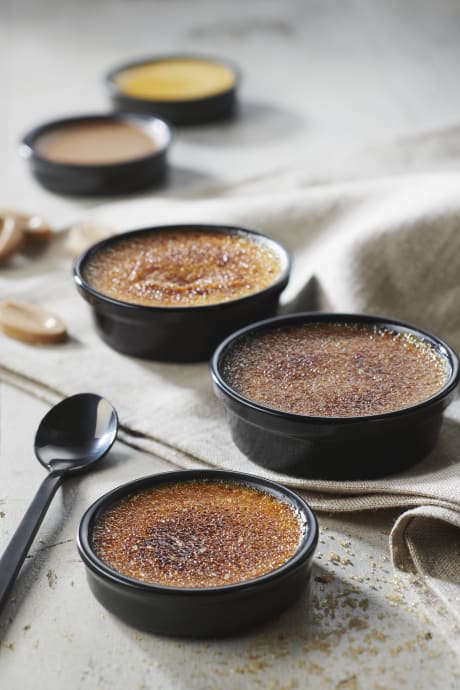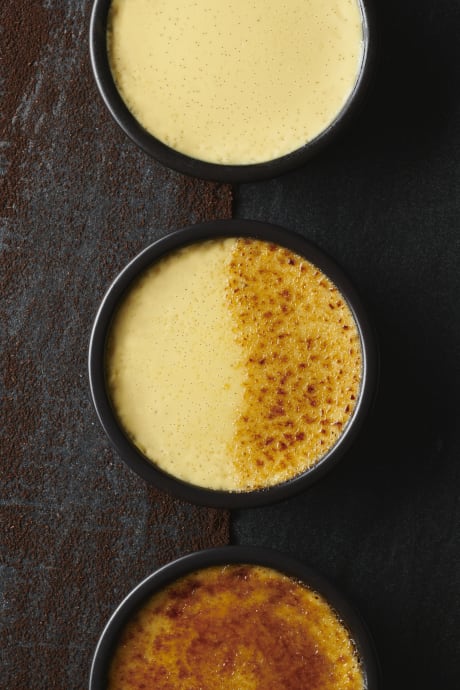You are using an outdated browser. Please upgrade your browser to improve your experience and security.
Crème brûlée
Contents :
Crème brûlée is a dessert with a caramelized, slightly crisp surface. It’s probably a variation on Catalan cream, which is very similar. Although traditionally infused with vanilla, crème brûlée can be flavored in lots of ways and it’s possible to make it savory too. Find out how to make a crème brûlée and find answers to all your questions about this dessert.

Crème brûlée recipe
First, we will give you a classic recipe for a crème brûlée flavored with vanilla or an ingredient of your choice. If you want to make a chocolate crème brûlée, go straight to the next recipe specially designed by our chefs.
Crème brûlée ingredients
The following quantities are recommended for 12 small pots of crème brûlée:
- 0.5l whole milk
- 0.5l liquid cream
- Vanilla bean split in half lengthwise
- 10-12 eggs
- 150-200g caster sugar
- Brown sugar
You can easily replace milk with a plant-based drink such as soy or coconut.
If you’d like a change from vanilla, you have plenty of options for flavoring your crème brûlée, including coffee, cinnamon, lemon, ginger, lavender, orange, gingerbread, pistachio, saffron, tea - even foie gras!
To make a Catalan cream, simply add 40g of cornstarch to your crème brûlée mix. You can also replace the brown sugar with white sugar.
Preparing your crème brûlée
- Preheat your oven to 320/340°C (160/170°C).
- Boil the milk and liquid cream in a saucepan along with the vanilla if you choose this flavoring.
- Let it cool and infuse at 160/165°F (70/75°C).
- Separate the egg whites into a container.
- Beat the yolks with the caster sugar until blanched.
- Gradually pour the milk and cream into the egg yolks and sugar.
- Pass the mixture through a fine strainer.
- If you have not used vanilla, flavor your mixture at this stage.
- Place the mixture in molds (traditionally terracotta pots are used).
- Immediately bake your crèmes brûlées for 28 minutes on lined baking trays or put them in a bain-marie.
- Turn the tray halfway through baking.
- Take the crèmes brûlées out of the oven and put them in the refrigerator. They must be very cold before you move on to the next step.
- When you are ready to serve, place a generous amount of brown sugar on your crèmes brûlées. The aim is for the brown sugar to stick to their entire surface.
- Tilt your crèmes brûlées to drain away any excess brown sugar.
- If necessary, use a water spray to help the brown sugar stick to the surface of your crèmes brûlées. This optional step will slow down the caramelization process, but will make it more uniform.
- Burn each crème brûlée using a caramelizing tool or blowtorch to make this dessert’s characteristic slightly crunchy caramel top.
Chocolate crème brûlée recipe
For a change from the classic recipe, why not make a Valrhona chocolate crème brûlée? Try this indulgent recipe developed by our chefs using milk chocolate or Blond Dulcey.
Chocolate crème brûlée ingredients
You will need the following ingredients to make 8 chocolate crèmes brûlées:
- 150g full-fat milk
- 300g liquid heavy cream
- 160g egg yolks
- 40g sugar
- 150g Jivara 40%milk chocolate or 140g Blond Dulcey (in drops)
- Brown sugar
If you use Blond Dulcey, you can add fleur de sel as it goes very well with this blond-colored white chocolate.
Preparing your chocolate crème brûlées
First, mix your liquid ingredients and sugar, then mix this with your chocolate in three stages, as if you were making a ganache. From step 9, follow the same instructions as for the classic crème brûlée above.
- Preheat your oven to 250°F (120°C).
- Heat the whole milk and liquid cream together in a saucepan.
- Beat the yolks with the caster sugar in a container until blanched.
- Gradually pour the milk and cream into the egg yolks and sugar.
- Pour one-third of the mixture into the chocolate. You don’t need to melt it first.
- Mix with an immersion blender until the emulsion is perfect.
- Add another third of the mixture and stir it in with a spatula.
- Pour in the last third and stir one last time.
Follow steps 9 to 16 of the basic crème brûlée recipe. They are as follows:
- Place the mixture in molds (traditionally terracotta pots are used).
- Immediately bake your crèmes brûlées for 28 minutes on lined baking trays or put them in a bain-marie.
- Turn the tray halfway through baking.
- Take the crèmes brûlées out of the oven and put them in the refrigerator. They must be very cold before you move on to the next step.
- When you are ready to serve, place a generous amount of brown sugar on your crèmes brûlées. The aim is for the brown sugar to stick to their entire surface.
- Tilt your crèmes brûlées to drain away any excess brown sugar.
- If necessary, use a water spray to help the brown sugar stick to the surface of your crèmes brûlées.
- Burn each crème brûlée using a caramelizing tool or blowtorch to make this dessert’s characteristic slightly crunchy caramel top.
Frequently asked questions about crème brûlée

From crème brûlée’s origins to tasting it, cooking it and caramelizing it, we answer all your questions about one of pastry-making’s most frequently used creams.
Where did crème brûlée come from?
If you are wondering who invented the crème brûlée, we have to tell you its origins are a mystery.
The first mention of crème brûlée in a French cookbook (Nouveau Cuisinier Royal et Bourgeois by cook François Massialot) dates back to the 17th century.
However, the very similar Catalan cream appears in a medieval cookbook written in the 14th century, the Llibre de Sent Soví.
What is the difference between Catalan cream and crème brûlée?
Catalan cream and crème brûlée differ in several ways:
- Unlike crème brûlée, Catalan cream contains cornstarch.
- Catalan cream is covered with white sugar rather than brown sugar.
- It appears that Catalan cream was not originally caramelized.
They are also used in different ways. In some places, Catalan cream appears in various desserts where crème pâtissière would be used elsewhere, such as puff pastry.
Which container should I use for crème brûlée?
Crème brûlée is traditionally cooked and served in terracotta ramekins. However, you can use other ovenproof containers, such as small porcelain dishes.
It’s also possible to prepare a “family-sized” version in a large dish, instead of individual portions.
How can I be sure that my crème brûlée is cooked?
To cook your crème brûlée, carefully follow the recipe described above. In particular, be sure to preheat your oven to the recommended temperature and stick to the advised cooking time.
Why isn’t my crème brûlée working?
If you mess up your crème brûlée before the caramelization stage, take a careful look at our recipes above to figure out where the problems are starting.
If caramelization is the problem, be sure to follow the steps provided. Your crèmes brûlées should be very cold when you cover them with brown sugar. Put them in the refrigerator at the right moment and don’t take them out too soon.
Which spirit should I use to flambé a crème brûlée?
If you’re wondering how to flambé your crème brûlée, remember that it shouldn’t be flambéd, but burned. So you don’t need alcohol, you need a blowtorch!
If you still want to flambé it, you should use a strong spirit like rum or calvados. However, you will not get the crispy surface that characterizes crème brûlée.
Your choice of spirit depends on how you have chosen to flavor your crème brûlée. Some spirits may change or mask its flavor.
How do I make a crème brûlée without a blowtorch?
We highly recommend using a caramelizing tool or blowtorch to make an authentic crème brûlée. There’s no satisfactory alternative in home kitchens.
If you work in a professional kitchen and have a salamander (an oven that has nothing but a grill at the top), this can be a handy alternative.
How is crème brûlée served?
Crème brûlée can be enjoyed warm or cold, but it’s important to wait until the very last moment before caramelizing its surface. Otherwise, it won’t be crisp.
Crème brûlée is usually served on its own, but it often comes as part of a selection of desserts with coffee. It might be accompanied by chocolate desserts such as mousse or a brownie.